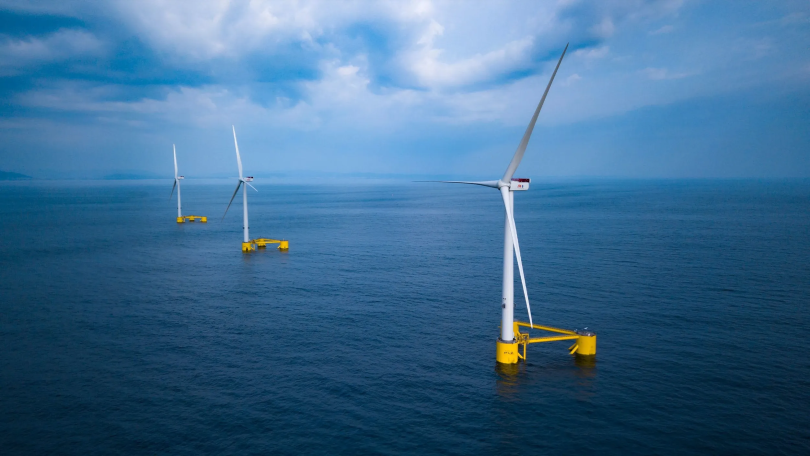For Immediate Release: May 10, 2023
SACRAMENTO – Today, the California Energy Commission (CEC) adopted a report describing various options for a coordinated, comprehensive and efficient permitting and environmental review process of offshore wind projects off the California coast.
The report, titled Assembly Bill 525 Offshore Wind Energy Permitting Roadmap, was developed in response to Assembly Bill 525 (Chiu, Chapter 231, Statutes of 2021). The law also resulted in the CEC establishing a goal to deploy up to 5,000 megawatts (MW) by 2030 and 25,000 MW of offshore wind by 2045 — enough electricity to power 3.75 million homes initially, with a goal of powering 25 million homes by midcentury.
“The Energy Commission is proud to deliver this permitting roadmap detailing the critical role each level of government plays in achieving California’s offshore wind goals,” said CEC Chair David Hochschild. “This is an important milestone on our journey to deploy 25,000 megawatts by midcentury in a way that’s environmentally responsible and provides benefits to all residents, especially in rural coastal communities where the projects will be built.”
CEC staff considered a few approaches and concluded that a coordinated approach would leverage existing expertise and staff resources housed in each state agency while allowing for permitting process improvements and streamlining, which can result in faster and more predictable project permitting. However, staff emphasized it is important to evaluate and vet additional options and suggestions fully before deciding the best permitting pathway.
The report includes information on state permitting agencies and processes for a more complete picture of the landscape beyond the federal processes. It delineates responsibilities each agency has for different aspects of offshore wind development, including application and review process for projects within their jurisdictions.
It also describes the existing review timelines that a project currently would follow, estimating it could take between 6 and 10 years for a project developer to obtain all the needed federal approvals, 4 to 6 years to obtain the state approvals, and 2 to 3 years to obtain local approvals before construction could begin.
The CEC developed this report in coordination with federal, state, and local agencies, tribal governments, and stakeholders such as fishery groups and other ocean users. The report is one of three interim products contributing to the development of the state’s Offshore Wind Strategic Plan that will be submitted to the Legislature this year.
Additional Actions on Offshore Wind
California is home to some of the best offshore wind resources in the country, a power source that can play a major role in helping the state achieve 100 percent clean electricity and carbon neutrality. Offshore wind is a critical clean energy source, complementing solar energy by providing generation at the end of the day and into the evening as the sun sets.
- First Lease Sale: In December 2022, the Bureau of Ocean Energy Management, which manages the development of the nation’s offshore energy and mineral resources, held the first California sale for offshore wind leases. This auction resulted in the awards to five lease holders off California’s North and Central Coasts.
- Job Creation: In addition to providing clean renewable energy, California’s offshore wind industry is expected to create a wide range of good-paying jobs, as explored in another report required by AB 525 titled A Preliminary Assessment of Economic Benefits of Offshore Wind. Most jobs are expected to be in the local and regional supply chain and manufacturing sectors, although other jobs, such as dock workers and watercraft operators, would also be required.
- State Investments: Economic benefits will also come from investments in seaport and waterfront facilities. Plans are underway for renovations at the Port of Humboldt Bay with $10.5 million in funding approved by the CEC earlier this year. The 2022–23 state budget builds on this effort and proposes additional funding for other needed infrastructure upgrades at ports and waterfront facilities.
- Stakeholder Engagement: To strengthen collaboration, this week the CEC hosted an offshore wind energy symposium, featuring a U.S. Department of Energy workshop, to discuss the efforts necessary to advance floating offshore wind, learn about the international experience and identify what it will take to make the first West Coast floating offshore wind projects successful.
- Federal Partnership: In February, California signed onto a White House-led federal-state partnership designed to fast-track efforts to bring cleaner and cheaper energy to Americans, create good paying jobs and build an American supply chain for offshore wind.
- International Collaboration: Also in February, the CEC and the Danish Energy Agency (DEA) signed a new agreement to promote sharing of knowledge, experiences, data, and best practices for offshore wind energy.
To learn more about California’s offshore wind efforts, visit the CEC’s Offshore Renewable Energy Page.
###
About the California Energy Commission
The California Energy Commission is the state's primary energy policy and planning agency. It has seven core responsibilities: advancing state energy policy, encouraging energy efficiency, certifying thermal power plants, investing in energy innovation, developing renewable energy, transforming transportation, and preparing for energy emergencies.
Newsroom
Media Contact
Media and Public Communications Office
MediaOffice@energy.ca.gov
(916) 654-4989

